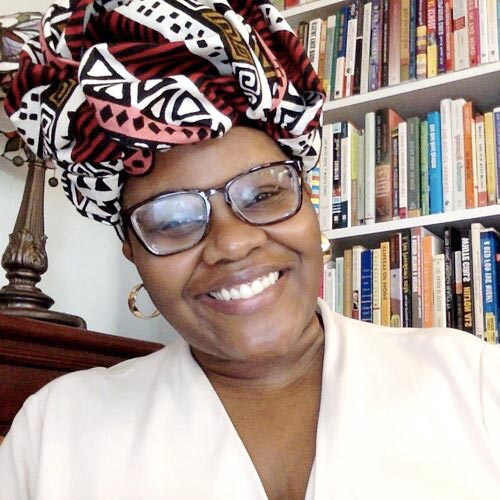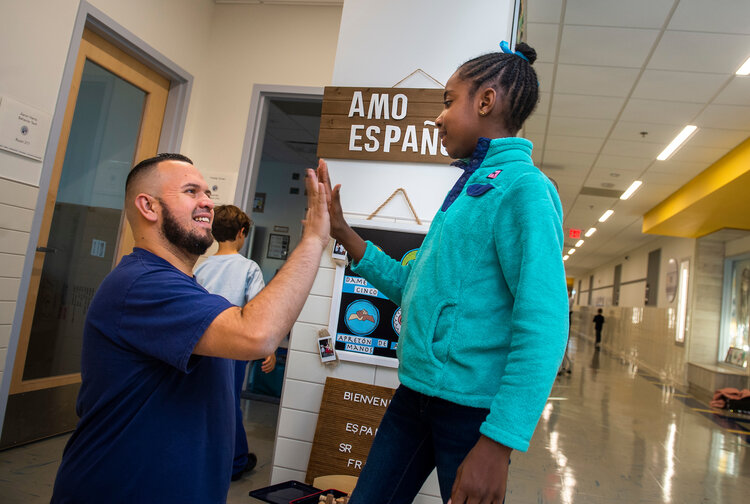“I believe with all my heart, we will never go back”: How Navigator is making the Whole Child Leap


Jenee here! Last week, I shared the central question on our minds at Transcend: “What now feels possible for education that didn’t before this massive disruption?” We’re on a mission to support communities across the country in recovering from our multiple crises in ways that lay the groundwork for leaps toward far better, more equitable learning.
This week I’m bringing you an example from one of our partners, Navigator Schools, a charter network in California. They are adopting the Strong Start model developed by Van Ness Elementary, a District of Columbia Public Schools elementary school. Navigator’s story inspires me because it illustrates how a school community so adept at tiered academic intervention can make the leap towards a Whole-Child focus by integrating community-centered, relationship-rich rituals and systems. The lessons of remote learning have turbocharged Navigator’s motivation to ensure that socio-emotional well-being shows up in every part of their learning environment. Because of the deep R&D done by Van Ness, another Transcend partner, Navigator didn’t have to start this innovation journey from scratch. They had a model to start with, grounded in the science of learning, and now they have a bridge to further innovate on their design over time.
When Sharon Waller, Navigator’s Director of Student Services, reflected on what she most wants for young people in their community during this critical recovery moment, she said, “I’m reminded of the Maya Angelou quote, ‘People will forget what you said…but never forget how you made them feel.’ We want our young people to know that they are loved and deeply cared for [so that] they will be people who make others feel loved.”
HOW CAN SCHOOL NURTURE THE SENSE OF BELONGING WHICH UNDERPINS LOVE?
At Navigator, which serves 1,360 young people and more than 150 teachers / instructional staff across three K-8 campuses, they are betting that Strong Start is the right innovation for their community at this time. Strong Start includes four rituals, even when virtual:
- Community Building: an activity to foster community
- Active Calming: an activity to practice calm-down strategies
- Purposeful Partnering: an activity to fuel peer connection
- Goal Setting: an activity to set an intention for the day

This fall, Navigator, a member of Transcend’s Recovery to Reinvention cohort in partnership with Silicon Schools, began implementing Strong Start across all three campuses. Jessie Cornia, Multi-Tier System of Supports (MTSS) Coordinator, shares that the first time she saw Strong Start, “[My] mouth was open. We just thought, ‘WOW!’ and were so inspired. We have a motto, ‘Every child by name and need.’ With Strong Start we saw teachers literally connecting with and addressing every single child’s needs.”
Navigator’s learning environments are grounded in core principles, including “robust multiple tiers of support for academics and behavior.” While they had long focused on leveled interventions for academics, they began to notice that they were getting more and more behavioral referrals. They knew they needed to apply the same data-driven intensity and purposeful approach to socio-emotional learning. “With the Van Ness example, we saw a school that took rigorous academics and blended it with the brain science around creating a safe environment in ways that we haven’t seen before,” says Sharon. For many schools, the rituals and practices that fall under the umbrella of SEL are often consigned to one-off units or lessons, not deeply embedded within daily practice. Strong Start is the kind of model that gets better and better with more use.
The Whole-Child Focus leap is proving more critical than ever for school communities in the COVID era.
I’m reminded of the Maya Angelou quote, ‘People will forget what you said…but never forget how you made them feel.’ We want our young people to know that they are loved and deeply cared for [so that] they will be people who make others feel loved.
Sharon Waller, Navigator’s Director of Student Services
With remote and hybrid learning, schools are seeing that learners need to build social and emotional competencies that can withstand the often disconnecting experience of virtual learning. Reflecting on student surveys, Jessie observed, “The number one thing we hear from kids is that they don’t feel connected to adults in a virtual environment. We needed something that forces the intimacy that we wouldn’t get online if we weren’t conscientious.”
The effects of Strong Start have been tangible for young people and the adults who serve them. In one 3rd grade classroom, a young boy who frequently turned off his camera and disengaged is now comfortable in breakout groups and talking vividly about his love for BMX bikes. Attendance in one school has reached 99% after Strong Start, and while that may appear correlative, the principal and teachers believe that having a “softer start” to the day helps everyone get into constructive emotional states, ready to learn.
In talking with Sharon and Jessie, I felt the warm vibes one does in the presence of deeply passionate and curious educators. From their story of reinventing, I also took something else: one small change can beget several other changes. And you often can’t predict which ones. After implementing Strong Start, Navigator started weekly student surveys (K-2nd, 3-5th, middle school), which counselors read in full to inform personalized and proactive engagement plans. These surveys give teachers and staff a far broader perspective on student experience. They also reflect how the spirit of Strong Start has shifted adults’ internal language from problem-finding to asset-based inquiry. It has changed the nature of teacher coaching from a mainly academic focus to a broader (and still rigorous) focus on “student engagement.”
“The main challenges we’ve had are ensuring we integrate this model within our coaching and support for teachers. Adults can be tricky and sticky, but the more you practice [Strong Start], the more it benefits all your practices,” Jessie said. One teacher reflected in a survey, “Being consistent with Strong Start has helped build a sense of community in my morning class. I have noticed that since I stopped in my other class [the students perform Strong Start with a different group now], there is no sense of community at all, and the kids are not as open.” Despite these early challenges Jessie is certain that this model is right for the Navigator community, “I believe with all my heart, we will never go back.”
WHAT WE’RE LEARNING ABOUT ROADS TO REINVENTING FROM NAVIGATOR’S STORY:
- Even schools with relatively strong culture during in-person school can find that distance learning reveals the need for a deeper focus on whole-child, relationship-rich, community-focused experiences.
- Schools don’t have to develop these new learning experiences from scratch; they can adopt from models that other communities have invested the R&D to build. This saves the adopting schools a lot of time and capacity.
- The process of adopting a model developed elsewhere can itself generate new innovations. For example, Navigator’s data-driven DNA combined with Van Ness’s whole-child DNA led to a new weekly student survey practice to better inform both academic and broader supports.
- District innovations, such as the Van Ness’s model, can be codified and spread to other communities of all governance models. Great models transcend governance structures.
Transcend supports communities to create and spread extraordinary, equitable learning environments.

